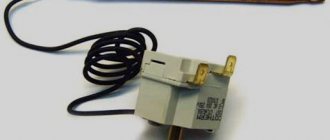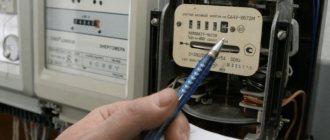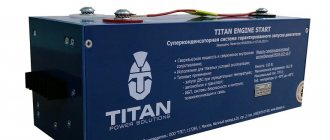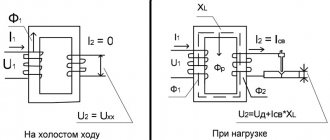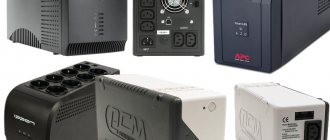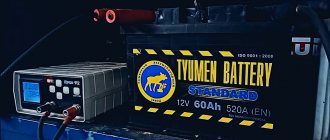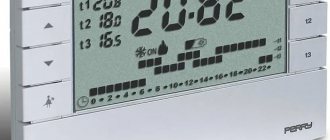A thermostat is a device that allows you to maintain the temperature within specified parameters.
Below you will learn how a thermostat works, how it works and the basic principle of its operation. Without noticing this, we often come across a thermostat in life: it makes sure that the refrigerator maintains the desired temperature, does not overheat or freeze, thanks to it the kettle is heated to the desired temperature, and the car quickly warms up and does not break down due to the high engine temperature . You will learn why a thermostat is needed in different devices and what needs to be done to identify faults.
What is a thermostat
A thermostat is a discrete mechanical device that, when a given temperature setpoint is reached, changes its state or the state of its electrical contacts.
These contacts, for example, can be used in relay electrical circuits, starting or stopping various units, or transmitting information about the temperature reached to the automated process control system. The word itself comes from two Greek words: “θερµο-”, which means heat and “στατός” - standing, motionless.
Unlike analog temperature sensors such as a thermocouple or resistance thermometer, a thermostat will not show the true temperature value at a specific point in time. Its task is only to “work” at a preset temperature value, that is, to change its state. After this, depending on the type of thermostat, the required control actions are performed.
Thermostats are used in devices or systems that heat or cool something to specified temperature values. For example, in refrigerators, heating appliances, cooling systems for automobile engines, industrial ovens, etc.
What does a thermostat consist of and what is its operating principle?
The design of the thermostat and its operating principle depend on the type of sensing element used. These can be bimetallic plates or metal capsules with capillary tubes filled with liquid or gas.
A bimetallic strip consists of two dissimilar metal strips with different coefficients of thermal expansion that are welded together. During heating, one of the metal plates expands more, which leads, when a given temperature is reached, to its bending or straightening.
Gas-filled bellows
The problem with bimetallic strips is that they take a long time to heat up or cool down, so they don't respond quickly to temperature changes. An alternative thermostat design detects temperature changes more quickly by using a pair of metal discs with a gas-filled bellows between them. The discs have a large surface area so they respond quickly to heat, and they are corrugated (they have ridges on them) which makes them resilient and flexible. When the controlled medium heats up, the gas in the bellows expands and pushes the discs apart. An internal dial presses a microswitch in the center of the thermostat, turning off the electrical circuit (and the heating). As the room cools, the gas in the bellows is compressed and the metal discs are compressed again. The internal disk moves away from the microswitch, turning on the electrical circuit and turning the heating back on. You can also find thermostats with bellows in other applications (such as older cars), and instead of gas, they are sometimes filled with a volatile (low-boiling) liquid such as dilute alcohol; the exact chemical inside depends on the temperature range in which they must operate.
Photo: The thermostat regulates temperature using a pair of metal discs separated by gas-filled bellows that press a microswitch. As the temperature dial is turned, the dials move closer or further from the microswitch in the center. This means that the gas bellows must more or less expand to turn the electricity on or off, effectively raising the temperature at which the switch operates (and the room temperature).
How to check the thermostat operation
To check the thermostat, you can use the following method: when changing the temperature setpoint, characteristic clicks should be heard when passing a temperature value equal to the ambient temperature - closing and opening of contacts.
If the thermostat is removable, then you can try to heat its sensitive element and check the operation.
If, for example, we consider the thermostat in the oven, then by setting a certain temperature, after warming up, you can observe the burner flame: if it decreases and remains at the same level, then everything is in order. The accuracy of the result obtained can be achieved using a thermometer.
You can use a thermometer or a multimeter with a thermocouple to ensure that the thermostat set point is operating correctly. This method is suitable, for example, for a washing machine. A tester will also help, which, when connected to the thermostat contacts, will show their closing and opening.
Checking the thermostat and common faults
Thermostat malfunctions are most often associated with wear or corrosion. This may cause the valve to become stuck in the open, closed, or partially open positions. Signs of a constantly open thermostat, as well as a stuck in intermediate position situation, appear only at low temperatures (cold weather), when the engine warm-up becomes too long. A permanently closed position is a more serious problem and causes the engine to overheat, which can lead to permanent damage.
How to check if the thermostat is working properly
Also, the thermostat may be initially of poor quality, which often manifests itself as untimely opening. Early firing increases fuel consumption because the engine will take longer to reach operating temperature. When the valve on a large circuit operates later, engine wear increases.
The main way to check the thermostat involves removing it from the engine:
- The thermostat is dismantled and placed first in a container with hot (boiling) water. If the valve does not open or opens too slowly, it will require replacement. If the valve has tripped, perform a reverse check by placing it in cold water and monitoring the closing process.
Car thermostats cannot be repaired and require replacement if faults are detected. You should also know that different brands have different opening and closing temperature characteristics. Therefore, to ensure optimal engine operation, it is necessary to install models recommended by the car manufacturer.
Typical symptoms of malfunction
Motorists may notice problems with this unit based on the following signs.
- The motor heats up too quickly.
- The temperature rises to normal for too long.
- During the trip, the motor needle drops, and it rises when braking.
To identify defects, it is recommended to monitor all parameters of each part and arrive on time for professional diagnostics. Computer technology will help identify the slightest problems at an early stage, preventing the replacement of the device and extending the service life of your favorite “swallow”. It is worth listening to the recommendations of specialists in service centers, contacting serious auto repair shops with a license, good material and technical resources, and experienced craftsmen who understand the intricacies of technical devices.
Temperature breakdowns
- The main failure is overheating. This is the first call. You don't have to remove the part from the car. Just warm up the engine a little. If it turns out that the hose leading to the radiator is hot (and during normal operation it should be cold), then we can conclude that this is a breakdown.
- Another sign may be that when accelerating, the needle drops sharply, and when stopping, it rises.
- He is constantly open, which is not the right way. Then the lower deck heats up very quickly.
- The engine starts to boil even though it is closed. In such cases, it becomes necessary to open it. The opening temperature of the regulator is its only characteristic. It is usually indicated on the detail itself. It is difficult to say whether the state of the environment influences the discovery. But it is reliably known that the temperature of the coolant and the set one are influenced by the opening. It depends on the climate for which the car is intended. The manufacturer himself sets the proper opening for each specific model.
A brief tour of brands
As experts can advise you, it is better to buy original thermostats from well-known manufacturers. Otherwise they are called OEM spare parts. Their prices are high, but the spare part itself can serve for many years without a single misfire.
The following companies have products of the highest level: Mahle, Behr, Wahler (Germany), Valeo (France).
Some of the most popular brands are: Gates (USA), Febi, Meyle, SWAG (Germany), Facet (Italy), Calorstat by Vernet (France). The quality of the products is very high, the prices are not bad. By the way, in Ukraine and Russia these brands are widely known and in great demand.
Among the budget solutions, it is worth noting the following two companies: Starline (Czech Republic), JP Group (Denmark). The prices are very affordable, but the products themselves meet all quality standards.
You should avoid thermostats from little-known companies that have recently entered the market. The reason is simple: there is a high risk of stumbling upon counterfeit products that look almost no different from thermostats from large companies, but are inferior to them in absolutely everything.
Planned replacement
The thermostat belongs to the category of spare parts that does not have a regulated replacement period. A quality product lasts up to several years. If the thermostat breaks down, the engine suffers the most - the temperature regime is not maintained. There are two possible options here that are being considered regarding the position in which the thermostat is “stuck.” This may be either overheating of the engine, or, conversely, underheating due to intensive cooling. In the memory of service station workers, there are many cases when the thermostat on a car either worked properly or failed - individual copies of this part behave in the most interesting way.
Frequent causes of breakdowns are the use of unsuitable cooling fluids and the reluctance to change them on time. The worst option is to use water. We’ll talk about when the thermostat needs to be replaced, which manufacturing companies are worthy of attention, as well as what tricks seasoned car enthusiasts have.
Device
A car thermostat is made of non-corrosive metals - copper, brass, aluminum, or plastic. Its main element is a valve that regulates the flow of coolant. It is connected to a pin connected to a cylinder containing wax. Based on the type of housing, the following types of thermostats are distinguished:
1. Case-based, which are devices placed inside a case that has 2 or more pins, or is equipped with a two-level circuit.
2. Bodyless. Installed directly into the engine block.
conclusions
You can replace the thermostat yourself. At the same time, the faulty part should be replaced as soon as possible - this allows you to get rid of possible expenses for engine repairs. We also note that the thermostat should be checked on the eve of the onset of cold weather. A properly functioning part will not only reduce engine resource consumption, but improve heating of the car interior and normalize fuel consumption.
There are quite a lot of thermostats in different price categories on the market. We consider the above brands to be priority, their quality has been tested by time. A one-time replacement is enough to avoid having to think about the thermostat for several years.
We carry out diagnostics ourselves.
Without removing the thermostat from the car, you can easily monitor its operation. We warm up the engine, and then touch the hose from the thermostat to the radiator. Its normal state is: low temperature, comparable to air temperature. If it is hot, then you should either go to a service station, or try to dismantle it and carry out further diagnostics yourself.
We remove the thermostat and “ cook ” it. This is done very simply: place a thermometer and thermostat in a pan with clean water. We heat the water, trying to fix its temperature at the thermometer mark of 90°C. If the thermostat valve begins to open slowly, there is no reason to worry. This did not happen or the valve did not open completely; an urgent replacement will have to be carried out.
Thermostatic radiator valves
Pictured: This thermostatic valve regulates the flow of hot water through the radiator, preventing the room from overheating. If the room gets too hot, a wax thermostat is activated, which activates a valve, cutting off the flow of water through the radiator until the temperature drops again.
Temperature valves fitted to central heating radiators usually use wax thermostats. When radiators heat up to the level you set, the wax valves expand and reduce the flow of water through the radiator until the temperature drops again. When combined with room thermostats, these valves can protect your home from overheating—and are a good way to both save energy and money, and do your part to combat global warming.
Is it possible to handle the replacement yourself?
With the development of Internet resources, there are no problems in finding guides for replacing individual spare parts. If you want to replace the thermostat yourself, you need to get a sealant, a Phillips screwdriver, a basin for draining the coolant, and keys for “12” and “13”. Essentially, the replacement involves the following: drain the antifreeze, remove the decorative engine cover, disconnect the thermostat housing, remove the thermostat and install a new one. Often thermostats are designed in such a way that the side on which you install it matters. For ease of identification, the manufacturer makes marks such as “Front” and “Rad”, or an arrow pointing to the radiator. We recommend that you also change the clamps and seals during installation. After replacement, it is recommended to add antifreeze and ensure there are no leaks.
Some tips when purchasing
If you decide to buy a mechanical, electronic or electromechanical room thermostat for the boiler, it is advisable to adhere to the following recommendations:
- It is worth choosing a thermostat from the same company that manufactured the boiler. This will ensure greater compatibility and easier installation.
- When purchasing a device, you should take into account the area of the room and the desired temperature conditions.
- To reduce heat loss, it is necessary to insulate the room
